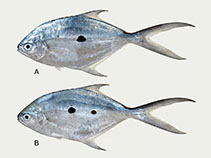| Family: |
Carangidae (Jacks and pompanos), subfamily: Trachinotinae |
| Max. size: |
42 cm TL (male/unsexed) |
| Environment: |
reef-associated; marine |
| Distribution: |
Eastern Pacific: endemic to the Marquesas Islands. |
| Diagnosis: |
Dorsal spines (total): 7-7; Dorsal soft rays (total): 23-26; Anal spines: 3-3; Anal soft rays: 23-25; Vertebrae: 24-24. This species is distinguished by the following characters: adults have only 1 or 2 large black spots on their sides and the largest spot larger than iris diameter (usually smaller than iris diameter in T. baillonii and equal to or larger than eye diameter in T. botla and T. coppingeri); no large spot positioned above the pectoral fin (adults with 1 or 2 large spots in T. botla and T. coppingeri); height of largest spot plotted against head length is also larger than in T. baillonii; heights of dorsal- and anal-fin lobes of adults usually shorter than in the other three species; D VI-I, 23?26; A II-I, 23?25; vomerine tooth patch usually chevron shaped and palatine tooth patch relatively long (Ref. 120856). |
| Biology: |
The adult specimens were collected from the surf zone (Ref. 120856). |
| IUCN Red List Status: |
Not Evaluated (N.E.) Ref. (130435)
|
| Threat to humans: |
harmless |
Source and more info: www.fishbase.org. For personal, classroom, and other internal use only. Not for publication.

